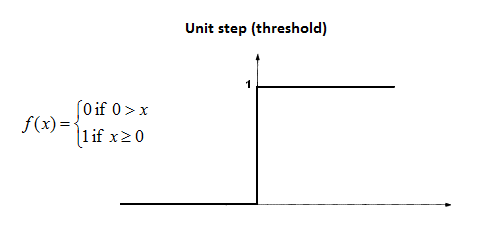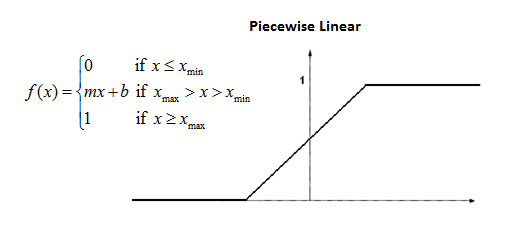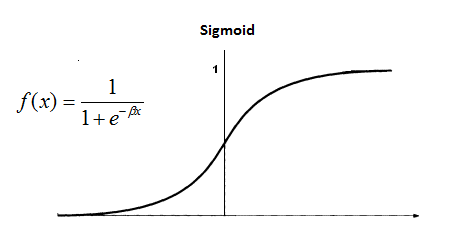Neural Network Structure
Neuron Scheme
Each neuron is an information processing unit. Basic elements are:
- Synapses/Connections - Characterised by a weight $w_i$ and a signal $x_i$.
- Adder - Sums the input signals from the weighted synapses.
- Bias - $b_k$ is added to the sum.
- Activation function $\phi$ - Usually a non-linear function that produces the final output $y_k$.
graph LR
x1 -->|w1| n[Neuron]
x2 -->|w2| n
xn -->|wn| n
b["bias (bk)"] --> n
n -->|vk| af["Activation Function (phi(v))"]
af --> output["output (yk)"]
Where:
- $\mathbf w^T_k=[x_{k0},\ldots,w_{km}]$
- $\mathbf X=[x_0, \ldots,x_m]$
Types of Activation Functions
Threshold/Heavyside Function
This has a binary output:
\[\phi(v)\begin{cases}1&\text{if}&v\geq0\\0&\text{if}&v<0\end{cases}\]- Limited to binary classification only.
- No gradient information.
Piece-wise Linear Function
\[\phi(v)=\begin{cases}1 & \text{if} &v\geq\frac12\\v+\frac12&\text{if}&-\frac12<v<\frac12\\0&\text{if}&v\leq-\frac12\end{cases}\]- Narrow window of non-saturation.
Sigmoid & Hyperbolic Tangent Functions
The following is a sigmoid function:
there is also another s-shaped continuous function using $\tanh$.
Their ranges are:
- Sigmoid: 0 to 1
- $\tanh$: -1 to 1
or
\[\begin{aligned} \phi(v)&=\tanh(v)\\ &=\frac{\exp(2v)-1}{\exp(2v)+1}\in(-1,1) \end{aligned}\]Rectified Linear Unit (ReLU)
Most common choice in state-of-the-art neural networks (deep learning):
\[\phi(v)=\max(v,0)=\begin{cases}v&v\geq0\\0&v<0\end{cases}\]- Non-linear
- Variants include leaky ReLU:
- Has a shallow negative gradient when $v<0$.
Network Architectures
Single-layer Feed-forward Network
One input layer of source nodes that project directly onto the output computation.
There are no cycles allowed.
The output can be calculated using the following function:
\[y_k(\mathbf X)=\phi\left(\sum^p_{j=0}W_{kj}X_j\right)\]Multi-layer Feed-forward Network
Has additional hidden layers in-between the input and output. These provide a more capable network:
- Typically the neurons of each layer take the previous layer as their input.
- Still no cycles.
The output can be calculated using the following function:
\[y_k(\mathbf X)=\phi\left(\sum^{p_\text{hidden}}_{j=0}W_{kj}\underbrace{\phi\left(\sum^{p_\text{input}}_{i=0}W_{ji}\overbrace{X_i}^\text{input layer}\right)}_\text{hidden layer output}\right)\]Convolutional Neural Networks (CNNs)
A class of multi-layer feed-forward network with a special type of local connections:
- Widely used for image classification.
- A convolution is used to gain deeper understanding of the image.
Recurrent Networks
These have feedback loops which form cycles in the graph:
- Feedback loops involve connections with unit-delay elements $z^{-1}$, which together with nonlinear activations enable the nonlinear dynamic behaviour of the network.
We can calculate the output of a recurrent, no hidden, delay one, self feedback network with the following:
\[y_k(n)\equiv y_k(\mathbf X(n),n)=\phi\left(\underbrace{\sum^{p_\text{input}}_{i=0}W_{ki}X_i(n)}_\text{current input}+\underbrace{\sum^{p_\text{output}}_{j=0}W_{kj}y_j(n-1)}_\text{past output}\right)\]Knowledge Representation
The primary task of a NN is to learn it’s environment. To accomplish this, we need to feed it with environment knowledge, which is based on:
- Observations - These are often noisy, contain errors and have redundant/missing information.
- These can be labelled or unlabelled with the ground truth for that sample.
Training Dataset Example
A set ${{x_i, y_i}}, i=1,2,\ldots$ of experimentally acquired data is referred as a training dataset:
- OCR:
- $x$ = Pixel values or curves.
- $y$ = A, B, C, …
Training Process
-
Choose a subset of the available observations as a training dataset to teach the NN.
This set should be diverse and representative of data used in production.
- Choose an appropriate architecture, with as many input nodes as the length of the input feature vector $x$ and output nodes needed for the output $y$.
- Train the network on the training dataset.
- Test the network with the remaining data.
-
https://www.saedsayad.com/artificial_neural_network.htm ↩ ↩2 ↩3
-
https://learnopencv.com/understanding-activation-functions-in-deep-learning/ ↩
-
https://www.researchgate.net/figure/A-single-layer-feed-forward-neural-network_fig1_228394623 ↩
-
https://www.researchgate.net/figure/Architecture-of-a-single-layer-feed-forward-neural-network_fig5_334439609 ↩
-
https://towardsdatascience.com/a-comprehensive-guide-to-convolutional-neural-networks-the-eli5-way-3bd2b1164a53 ↩






